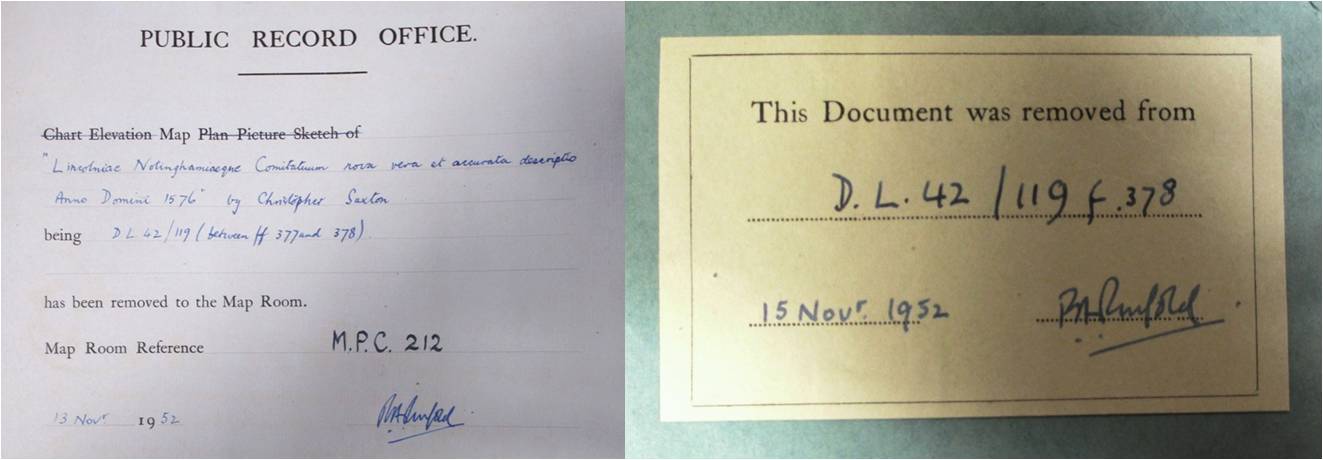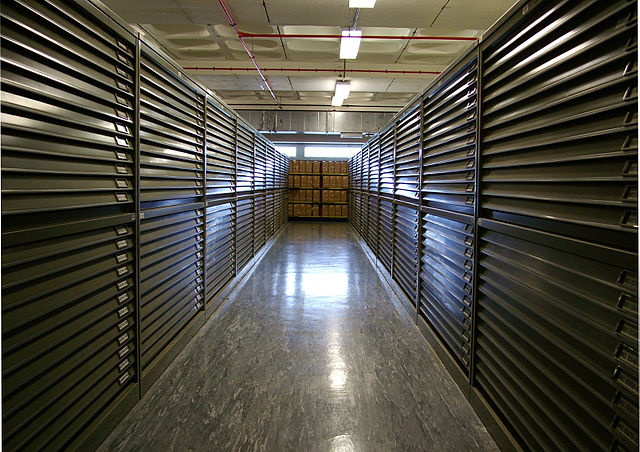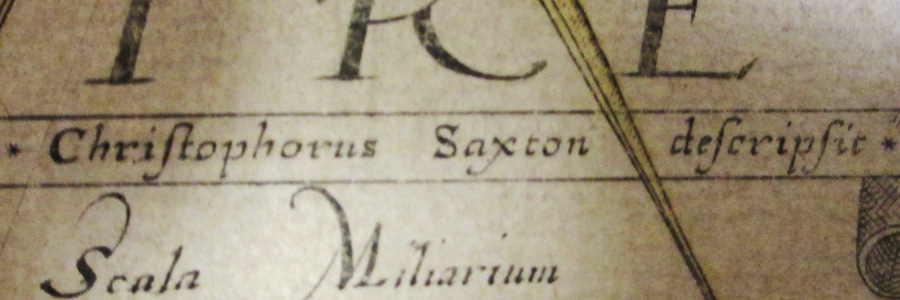Every so often, when I meet someone new at a social gathering, [ref] 1. Contrary to popular belief, even archivists go to parties sometimes. [/ref] I have a conversation that runs something like this:
New acquaintance: So, what do you do for a living?
Andrew: I’m an archivist.
Acquaintance: Archivist? What does that mean?
Andrew: It means that I look after historical records.
Acquaintance: Oh. What sort of records do you have, then?
Andrew (proudly): I work at The National Archives. We have government records, millions of them. [ref] 2. Yes, I do need to work on a better elevator pitch. [/ref]
Acquaintance (unconvincingly): How, erm, interesting. [ref] 3. The conversation doesn’t always go like this. Sometimes the person asks whether we have records about UFOs (we do) or whether I know a lot of secrets (I don’t). [/ref]
Andrew (hastily): I specialise in maps and plans and things like that.
Acquaintance (brightening up considerably): Oh, I love maps.
I am always bemused (and sometimes amused) by the fact that many people think maps are interesting but government records must be boring, even though our maps are government records. The large amount of media interest when batches of records are newly made available to the public demonstrates that many government records – even the ones that aren’t maps – are anything but boring.
In one way, it isn’t surprising that most people don’t know very much about what archivists do because the scope and responsibilities of the job vary quite a lot between different archives and between different roles within the same organisation. Some archivists work mostly with records made of paper and other ‘traditional’ materials but others work mainly or entirely with digital records. Some archivists, like me, spend a lot of time answering enquiries and talking to researchers, but others spend much less time doing that. [ref] 4. A couple of examples of different archivist roles and other jobs at The National Archives are featured on our website. [/ref] What we all have in common is our commitment to the records.
Sir Hilary Jenkinson, who was one of the most important British writers about archival theory and practice during the 20th century, [ref] 5. Jenkinson was Deputy Keeper – equivalent to Chief Executive – of the Public Record Office (which is now part of The National Archives) between 1947 and 1954. [/ref] had much to say to about the role of archivists. According to Jenkinson, an archivist’s primary duty is the physical and moral defence of the records in his or her care. [ref] 6. Hilary Jenkinson, A Manual of Archive Administration, Revised 2nd edition (London, 1965), pp 44, 83. [/ref] Why is this defence ‘moral’ as well as physical? Archivists believe that preserving the intellectual properties of records and their relationships with one another [ref] 7. Most records in archives are grouped together by origin and provenance rather than by subject. I hope to look at this in a future blog post. [/ref] – which Jenkinson rather grandly terms a moral defence – is just as important as looking after the records physically.
Staff here at The National Archives – and people working in archives all over the world – do many things in defence of the records in their care.
Our rules for people doing research in our reading rooms provide one example. Some of the things that we ask researchers to do are designed to help us ensure the wellbeing of the records. For instance, using foam wedges to support an old volume whilst reading it contributes to the physical defence of that record. Keeping the pages forming a bundle of loose papers in the same order that you found them – and being careful not to muddle them up with papers from another bundle – helps our moral defence of those records.
Another example is cases when part of a record has been extracted from the remainder because it is more appropriate to store it in a different format. [ref] 8. Another reason for extraction has been to allow part of a record to be ‘closed’ to public access whilst the remainder is ‘open’ for people to use in their research. See our page on the public records system for more information about access to public records. [/ref] For instance, some files, volumes or rolls that contained maps have had the maps taken out for treatment by a conservator. [ref] 9. A recent post on the British Library’s maps and views blog discusses the benefits of conservation treatment for maps. [/ref] The repaired maps have then been kept separately instead of being put back in their original places. [ref] 10. For more information about extracted maps, see: Geraldine Beech, ‘The National Archives Map Catalogue Retrospective Conversion Project’, The Cartographic Journal 42 (3) (December 2005), 241-244, pp 241-242; or Andrew Janes, ‘Of Maps and Meta-Records: Eighty-Five Years of Map Cataloguing at The National Archives of the United Kingdom’, Archivaria 74 (Fall 2012), 119-165, pp 126-128. [/ref]
For instance, the map shown above [ref] 11. MPC 1/212 [/ref] had been folded in half to fit inside a volume [ref] 12. DL 42/119 [/ref] and had perished along the fold line, leaving it in two pieces. In 1952, it was taken out of the volume, conserved and placed in a portfolio. Being stored flat is much more appropriate for a map of this size: it makes it much more readily usable and ensures the physical defence of the record.
But what about the moral defence? The process of extraction has secured the physical wellbeing of the map but at the cost of separating it from its proper intellectual context. To preserve the original structure of the record (of which the map is just a small part) a ‘dummy’ sheet has been put into the volume in its place. The dummy briefly notes what has been extracted, when the extraction was made, and where the extracted map can be found. [ref] 13. The code number M.P.C 212 was originally a storage location in our old building in Chancery Lane in central London. A slightly different version of the same code number (MPC 1/212) is now used as the catalogue reference. [/ref] Similarly, a label inside the portfolio containing the extracted map notes when it was conserved and which record it was extracted from.

Left: The dummy sheet records where the map used to be stored inside the volume. Reference: DL 42/119 folio 378. Right: This label notes which record the map came from
This system of preserving both the physical and the ‘moral’ wellbeing of records undergoing partial conservation treatment was first used in about 1926. We believe that Jenkinson himself (who was then a senior archivist at the Public Record Office) was probably responsible for devising this system. [ref] 14. Jenkinson, p 54. [/ref]
Nowadays, the intellectual relationship – and hence the moral defence of the records – is also preserved though our online catalogue entries. The extracted map has a separate catalogue entry from the entry for the volume that it came from. The two entries are cross-referenced to one another, so that users of the catalogue can understand the relationship between the map and the volume before looking at the records themselves.
The next time someone asks me what I do for a living, I might just say: ‘I’m a physical and moral defender of your heritage’. I wonder what kind of reaction that will provoke?




An archivist or a Civil Servant, that is the question. Whilst it is true that Government records get a lot of publicity this is only at a few Press events each year and from a few departments (others don’t meet the 30-year let alone the 20-year rule). The Press events are very limited and do not include the details of, for example, ‘The Right to Buy’ for council houses and the associated issues or the Poll Tax if the file had not gone missing before reaching TNA!, which have been transferred in the last week. If you look at the releases for 1983 only the Cabinet Office and the Prime Minister’s Office and 24 files from the Home Office are included and this hardly accounts for total Government business.
Speaking just for myself, I am both an archivist and a civil servant.
As a amateur historian/collector/archivist I’ve always wondered why archives are nof stored on a subject basis. Cross referencing of sources would ensure each item origins are clear.
Thank you for your comment, Richard. This is too complicated a question to address fully now (my half-promise to discuss it in a future blog post may have to bear fruit sooner than I expected) but here are some initial thoughts:
Archives are collective by nature. Their collective value is at least as important as their individual value. A few cross-references are unlikely to preserve this collectiveness adequately.
Mass-rearrangement is pretty impractical for anything other than the smallest sets of records.
Attempts at using a subject classification as the basis for arrangement wouldn’t actually help researchers anyway. The same records often have many different potential research uses. At best, a rearrangement would make a few research topics slightly easier at the expense of making other topics more difficult or even impossible.
Because government records are, generally, not created in the private interest but to reflect the activities of its various agencies (health, education,treasury, housing for example). Government’s interests lay not in the records so much as the various functions governments perform. This means that it is up to the researcher historian to construct a meaningful historical narrative from the available material. It would therefore be impossible to index and arrange archives under “housing” for instance because this would require the combined efforts of, if we view the subject historically, a land registration branch, a housing and development branch, registrar-general departments, governors office, public works branch, surveyor general’s office and a host of other bodies which collectively range across local, state and commonwealth government agencies. This level of co-ordination does not and has never existed across the tiers of government and therefore, given that the archive by and large reflects the functions and activities of some private bodies but mostly government, it cannot be expected that the archive should do anything other than mirror this arrangement and have it reflected in the archival collection. Archives are after all, repositories not libraries.
Thank you very much. for your comment, Carlos. You explain the point very well and succinctly. Much the same is true of non-government records held in other archives too, of course.
The reason why Government archives are not subject based is that there are the departmental barriers/borders that each department operates under and even within that department and the context as well as the content are important to understanding the records. Sir Humphrey would have a fit if it was suggested that all departments files were under one series. One could argue that, for example, records on economic or housing policy or even the Falklands War might seem to be ok but then you disrupt the history of functioning a department/organisation. The current arrangement and descriptions of records leaves a lot to be desired as the mention of individuals/organisations within a file can be missed. For example the independence of the Bank of England was considered in 1979, eighteen years before it happened, on a briefing for the new Government file.
Thank you Andrew I will look forward to reading your article.
David I can understand those reasons at a national level but is it relevant at a lower local level?
If I was to donate some records on a subject that already existed in an archive would my records be merged in or kept seperate?
Richard,
At a local level your records should be kept separate, even if they were duplicates or similar although the archive would be responsible for arranging the arrangement .
“The National Archives in the US can barely save 1% of of the government records, but we find ways to document everything from activities of the federal gov’t in war, peace & scientific exploration to decennial census of our families. After 40 years at this work I still am thrilled at the information that passes through my hands -carefully protected in sterile cotton gloves.
There was a time when this work was viewed a “keeper of the flame”. Personally, I am still learning.
Thank you, William. I rather like the phrase ‘keeper of the flame’ (not that we archivists allow naked flames in the reading rooms, of course!) Another (grand but highly appropriate) phrase that I saw used on Twitter recently is ‘guardian of democracy’.
We are all still learning. That’s partly what makes the job so interesting.
Thank you, Richard. As David says, if you were to donate a set of records to a local archives or (say) to a university archives, in most circumstances it would be treated as a separate collection. It is quite likely that your hypothetical donation would have some subject matter in common with other collections already held by that archives – the institution accepting your donation would undoubtedly have a collecting policy of some sort – but your donation would not be integrated into one or more existing collections purely on the basis of similar subject matter.
Thanks Andrew, a great overview. I am of the opinion that the physical and moral defence attitude helps to perpetuate the myth of the archivist as custodian and the archives as closed and almost sacred spaces. Archivists are seen as those separate from decision making related to keeping records, but this is not at all true.
I rather like to think of archivists as heritage facilitators and advocates. And we do not need to have custody of anything to perform these roles. In a digital age the idea of archivist as custodian is increasingly more difficult to maintain. What does preservation mean in these circumstances? And what really is the role of the archivist moving forward?
Recently some Australian archivists had a brief Twitter discussion about the role of archivists.
http://rhizomedigital.com.au/what-is-an-archivist-in-140-characters-or-less/
Thank you very much for your comment, Leisa. The Australian discussion makes interesting reading.
For myself, I don’t see the idea of an archivist being a custodian as a negative thing at all – although I hasten to add that my view of custodianship is one that promotes and facilitates the accessibility of the records rather than setting up barriers to it.
Regardless of whether or not we like to think of an archivist as having ‘custody’ of anything, I believe that the physical and moral defence of the records is still an important ideal and a useful way of framing our professional role. And being a facilitator and advocate for the records is another way of ensuring their moral defence (in a broader sense), isn’t it?
In reference to your suggestion that from now on your answer will be ‘I’m a physical and moral defender of your heritage’ – while studying Jenkinson’s theories on the Masters course at Aberystwyth, my coursemates and I came up with this catchy slogan:
“Archivist: Defender of the Truth”
It requires your best superhero stance.
Thank you, Ruth. I did the course at Aber too!
Hi Andrew,
Thanks for your article, was nice and witty, and discussions like this are always interesting.
Just a quick preservation question which is bugging me- when cataloguing maps and plans do you generally flatten them out if they have been rolled up, or, if for example thy are very delicate or there is a dearth of plans storage cabinets, do you just keep them rolled up? I imagine it’s a mixture of both, but any insight you can provide would be helpful. Cheers
Thank you for your comment, Garth. I’m glad you enjoyed the post.
Whether a map or other large flat document is stored flat or rolled after being conserved depends partly on the conservator’s judgement of what is appropriate and partly on the storage facilities available. Here, it’s generally been the case that very large maps are stored rolled and smaller ones stored flat. Maps that came to us in rolled format have nearly always stayed that way, though.
Sometimes maps come in other formats. The Foreign Office used to keep much of its map collection folded up to a standard size and these maps (now in record series FO 925) are still kept folded.
Most of the maps among our records actually came to us within files, boxes, volumes or rolls of other records and most of these are still kept within those records, unless they have required conservation treatment.
That’s great, nice and clear. Many thanks Andrew